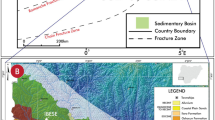Abstract
Like many phosphorite deposits in the world, the Baltic Middle Cambrian and Lower Ordovician phosphate-bearing basin owes its origin primarily to microbial activity. Colossal accumulations of valves and detritus of lingulates (phosphate brachiopods, mainly from the orders Lingulida and Acrotretida) are the main sources of phosphate material in this basin. The fossilization of the valves of these brachiopods was based on their early postmortem mineralization, which made the valves resistant to destruction. Bacteria were the drivers of this process. This was followed by transfer, breaking, redeposition, and accumulation of the valves and valve fragments in suitable areas of the sea.

Similar content being viewed by others
REFERENCES
Allison, P.A., Phosphatized soft-bodied squids from the Jurassic Oxford Clay, Lethaia, 1988, vol. 21, pp. 403–410.
Astafieva, M.M., Gerasimenko, L.M., Geptner, A.R., Zhegallo, E.A., Zhmur, S.I., Karpov, G.A., Orleansky, V.K., Ponomarenko, A.G., Rozanov, A.Yu., Sumina, E.L., Usha-tinskaya, G.T., Hoover, R.B., and Shkolnik, E.L., Iskopaemye bakterii i drugie mikroorganizmy v zemnykh porodakh i astromaterialakh (Fossil Bacteria and Other Microorganisms in Terrestrial Rocks and Astromaterials), Rozanov, A.Yu. and Ushatinskaya, G.T., Eds., Moscow: Paleontol. Inst. Ross. Akad. Nauk, 2011.
Bakterial’naya paleontologiya (Bacterial Paleontology), Rozanov, A.Yu., Ed., Moscow: Paleontol. Inst. Ross. Akad. Nauk, 2002.
Chuang, S.H., Growth and postlarval shell of Lingula unguis (L) (Brachiopoda), Proc. Zool. Soc. London, 1961, vol. 137, pp. 299–310.
Emig, Ch.C., Conditions of fossilization du genre Lingula (Brachiopoda) et implications paléoecologiques, Palaeogeogr., Palaeoclimatol., Palaeoecol., 1986, vol. 53, pp. 245–263.
Gerasimenko, L.M., Goncharova, I.V., Zavarzin, G.A., Zhegallo, E.A., Pochtareva, I.V., Rozanov, A.Yu., and Ushatinskaya, G.T., Dynamics of release and uptake of phosphorus by cyanobacteria, in Ekosistemnye perestroiki i evolyutsiya biosfery. T. 1 (Ecosystem Restructuring and Evolution of the Biosphere. Vol. 1), Moscow: Nedra, 1994, pp. 348–353.
Gerasimenko, L.M. and Orleansky, V.K., Actualistic paleontology of cyanobacteria, in Trudy Inst. Mikrobiol. im. S.N. Vinogradskogo (Trans. Vinogradsky Inst. Microbiol.), 2004, vol. 12, pp. 80–108.
Iwata, K., Ultrastructure and mineralization of the shell of Lingula unguis Linne (Inarticulate brachiopod), J. Fac. Sci. Hokkaido Univ. Ser. IV, 1981, vol. 20, no. 1, pp. 35–65.
Kowalewski, M., Taphonomy of a living fossil: the lingulid brachiopod Glottidia palmeri Dall from Baja California, Mexico, Palaios, 1996, vol. 11, pp. 224–265.
Lucas, J. and Prevot, L., The synthesis of apatite by bacterial activity: mechanism, Sci. Geol. Mem., 1985, vol. 77, pp. 83–92.
Popov, L.E., Khazanovich, K.K., Borovko, N.G., Sergeeva, S.P., and Sobolevskaya, R.F., Opornye razrezy i stratigrafiya kembro-ordovikskoi fosforitonosnoi obolovoi tolshchi na severo-zapade Russkoi platformy (Reference Sections and Stratigraphy of the Cambrian-Ordovician Phosphorite-Bearing Obolus Beds in the Northwest of the Russian Platform), Leningrad: Nauka, 1989.
Priroda fosfatnykh zeren fosforitov krupneishikh basseinov mira (The Nature of Phosphate Grains of Phosphorites in the Largest Basins of the World), Vladivostok: Dal’nauka, 1999.
Rozanov, A.Yu. and Zhegallo, E.A., On the problem of the genesis of ancient phosphorites of Asia, Litol. Polezn. Iskop., 1989, no. 3, pp. 67–82.
Ushatinskaya, G.T., Drevneishie lingulyaty (The Oldest Lingulates), in Tr. Paleontol. Inst. Ross. Akad. Nauk (Trans. Paleontol. Inst. Russ. Acad. Sci.), 1995, vol. 262, pp. 1–91.
Ushatinskaya, G.T., On the role of bacteria in the preservation of lingulid shells from the Lower Paleozoic of the Baltic States, Dokl. Akad. Nauk SSSR, 1990, vol. 311, no. 1, pp. 215–218.
Williams, A., Cusack, M., and Mackay, S., Collagenous chitinophosphatic shell of the brachiopod Lingula, Philos. Trans. R. Soc., B, 1994, vol. 346, pp. 223–266.
ACKNOWLEDGMENTS
The author thanks the team of the Instrument Analytics Office of the Borissiak Paleontological Institute (Russian Academy of Sciences) E.A. Zhegallo and R.A. Rakitov for their assistance in studying the material using the scanning electron microscope.
Funding
This research was supported by the Russian Foundation for Basic Research, project no. 19-04-01027.
Author information
Authors and Affiliations
Corresponding author
Ethics declarations
The author declares that she has no conflicts of interest.
Additional information
Translated by A. Panyushkina
Rights and permissions
About this article
Cite this article
Ushatinskaya, G.T. Role of Bacteria in the Accumulation of Cambrian–Ordovician Phosphate-Bearing Obolus Beds in the North-West of the Russian Plate. Paleontol. J. 56, 117–122 (2022). https://doi.org/10.1134/S0031030122020137
Received:
Revised:
Accepted:
Published:
Issue Date:
DOI: https://doi.org/10.1134/S0031030122020137




